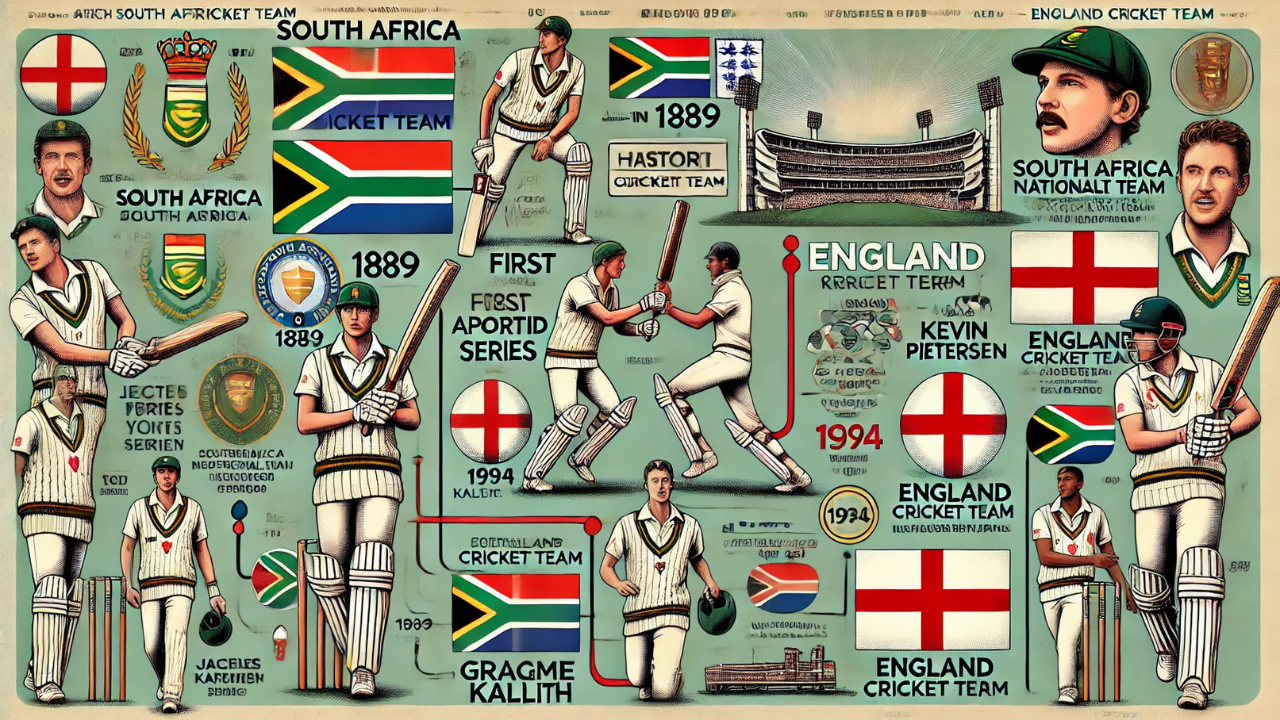The rivalry between the South Africa National Cricket Team and the England Cricket Team is one of the most enduring and exciting matchups in the history of cricket. south africa national cricket team vs england cricket team timeline This longstanding competition has not only provided countless moments of brilliance but has also been influenced by political, social, and cultural contexts. From early encounters in the late 1800s to the modern-day battles, the history of these two teams offers a compelling story of sport, resilience, and international drama. In this article, we delve into the rich timeline of this rivalry, exploring the milestones and unforgettable moments that have defined it.
1. Early Encounters: The Origins of the Rivalry
The rivalry between South Africa and England began in the late 19th century, when cricket was still evolving into the international sport we know today. Their first official match took place in 1889, a one-off Test series that set the stage for future encounters. At the time, South Africa was a relatively new player on the international cricket scene, and their matches against England were seen as significant milestones for the country’s cricketing history.
During these early years, the encounters were sporadic, with political and logistical barriers influencing the frequency of matches. Despite the challenges, these initial meetings were crucial in establishing the foundations for what would later become a fierce rivalry. The English team, led by some of the best cricketers of the era, such as W.G. Grace and C.B. Fry, often dominated these encounters. However, South Africa, with emerging players like Jimmy Sinclair and Aubrey Faulkner, began to show promise, hinting at the competitive edge they would bring to future encounters.
The first decades of the rivalry were marked by one-sided encounters, with England asserting its dominance. Yet, South Africa’s players were steadily improving, and these early matches were crucial in establishing the country’s cricketing identity. As the rivalry progressed, the balance between the two teams began to shift, and the stage was set for more dramatic showdowns in the 20th century.
2. The 20th Century Showdowns

The 20th century saw the South Africa vs. England cricket rivalry grow into one of the most intense in the sport. This period was crucial as it saw the teams face off in numerous iconic series, with both sides enjoying their moments of triumph. One of the defining features of these encounters was the period of exclusion for South Africa, as the country was banned from international cricket due to its apartheid policies. From 1970 until 1991, South Africa was isolated from the cricketing world, and this political decision had a profound impact on the rivalry with England.
Despite this hiatus, the rivalry was far from forgotten. England continued to play against other nations, with their cricketing prowess thriving. However, the absence of South Africa from the international stage meant that when they eventually returned to Test cricket in 1991, the anticipation for their first series against England was palpable. The 1994 series in South Africa, which marked the end of the apartheid era, was a historic moment. South Africa’s return to international cricket was celebrated by fans across the world, and their clash with England was eagerly awaited.
This series saw South Africa emerge as a dominant force in international cricket, with players like Allan Donald, Hansie Cronje, and Jonty Rhodes leading the charge. The competitive nature of the rivalry had shifted, with South Africa now able to challenge England on an equal footing. The 20th century was not just about historical context but about the rise of new stars and a shift in the balance of power in world cricket. Matches between the two nations were now fiercely contested, with thrilling encounters and memorable moments defining the period.
3. The Post-Apartheid Era: Renewed Rivalry
The post-apartheid era brought a new dynamic to the South Africa vs. England rivalry. With the return of South Africa to the international cricket fold, the competition between the two sides gained fresh momentum. The mid-1990s saw South Africa solidify its position as one of the top teams in the world, and their rivalry with England became one of the most eagerly anticipated fixtures in the international cricket calendar.
During this time, players like Graeme Smith, Jacques Kallis, and Mark Boucher emerged as key figures for South Africa. They were instrumental in building a new era of South African cricket, one that would challenge England’s dominance in the sport. One of the most notable series during this period was the 2003 World Cup, where South Africa hosted the event. Although South Africa did not win the tournament, their performances were impressive and reaffirmed their position as one of the strongest cricketing nations.
England, too, had its own crop of exceptional players during this period. The likes of Kevin Pietersen, Andrew Strauss, and Flintoff brought a new edge to England’s cricketing side. Their rivalry with South Africa took on new significance in the mid-2000s, especially in series such as the 2008 England tour of South Africa, where both teams exchanged thrilling victories, and key performances from players like Pietersen and Kallis kept fans on the edge of their seats.
What made the post-apartheid rivalry even more captivating was the individual brilliance from players on both sides. Whether it was Kallis’s all-round performances or Pietersen’s aggressive batting, each series between the two teams had its moments of magic, showcasing the growth and global stature of both cricketing nations.
4. Recent Encounters: The Modern-Day Rivalry
In the last decade, the South Africa vs. England rivalry has evolved into a modern-day spectacle, with high-profile players continuing to drive the competition. England’s cricketing prowess has continued to flourish with new stars like Joe Root, Ben Stokes, and Jofra Archer, while South Africa has remained competitive with players such as Quinton de Kock, Faf du Plessis, and Kagiso Rabada. These players have taken the rivalry to new heights, with their performances adding to the drama and excitement of each series.
The most recent series between the two teams have been characterized by intense competition and remarkable moments. The 2019 and 2020 series were some of the most memorable, with each match offering a dramatic storyline. In these encounters, England’s aggressive approach to the game, especially in limited-overs cricket, has met its match in South Africa’s disciplined and strategic play.
The balance of power has often shifted between the two teams, with England’s rise in the limited-overs format clashing against South Africa’s stronghold in Test cricket. This modern rivalry is not just about cricketing skills but about tactics, fitness, and mental resilience. With both teams having different styles of play, every match brings a new dynamic to the table, making each series unpredictable and exciting for cricket fans worldwide.
Conclusion
The rivalry between the South Africa National Cricket Team and the England Cricket Team is one of the most storied in cricket’s history. From their early encounters in the late 1800s to the fierce competition seen in the modern era, this rivalry has seen countless memorable moments, with both teams having their time in the sun. Political contexts, like South Africa’s exclusion from international cricket, and the individual brilliance of players like Jacques Kallis, Kevin Pietersen, and Faf du Plessis have all contributed to making this rivalry so captivating.
As the two teams continue to evolve, there’s no doubt that the future will bring more thrilling encounters, with cricket fans eagerly awaiting the next chapter in this historic rivalry. With both teams having world-class players and distinct styles, the South Africa vs. England rivalry is sure to remain one of the most exciting fixtures in international cricket for years to come.
FAQs
What is the historical significance of the South Africa vs. England cricket rivalry?
The rivalry has evolved over more than a century, shaped by political and cultural influences, creating one of the most competitive fixtures in cricket.
When did South Africa first play against England in cricket?
The first official match took place in 1889, marking the beginning of a long and fierce rivalry.
What are some of the most memorable matches between South Africa and England?
Memorable matches include the 1994 series after South Africa’s return, the 2008 series, and several thrilling encounters in the 2019 and 2020 series.
How has South Africa’s exclusion from international cricket affected the rivalry?
South Africa’s exclusion due to apartheid prevented many encounters, but their return in 1991 added excitement and rekindled the rivalry.
Who are some of the key players in the South Africa vs. England rivalry?
Key players include Jacques Kallis, Graeme Smith, Kevin Pietersen, and Ben Stokes, all of whom have contributed significantly to the rivalry.
What was the impact of the apartheid era on the South Africa vs. England cricket matchups?
The apartheid era led to South Africa’s exclusion from international cricket, temporarily halting the rivalry but also adding historical significance to future matchups.
How have the teams’ strategies changed over the years?
England has adopted a more aggressive approach, particularly in limited-overs cricket, while South Africa has maintained a disciplined and strategic style, especially in Test cricket.
What can we expect from future South Africa vs. England cricket encounters?
Future encounters are expected to continue the thrilling rivalry, with both teams boasting world-class players and evolving strategies, promising more dramatic and memorable moments.
You May Also Read: https://ventsbuzz.pro/miami-heat-vs-charlotte-hornets-match-player-stats/




